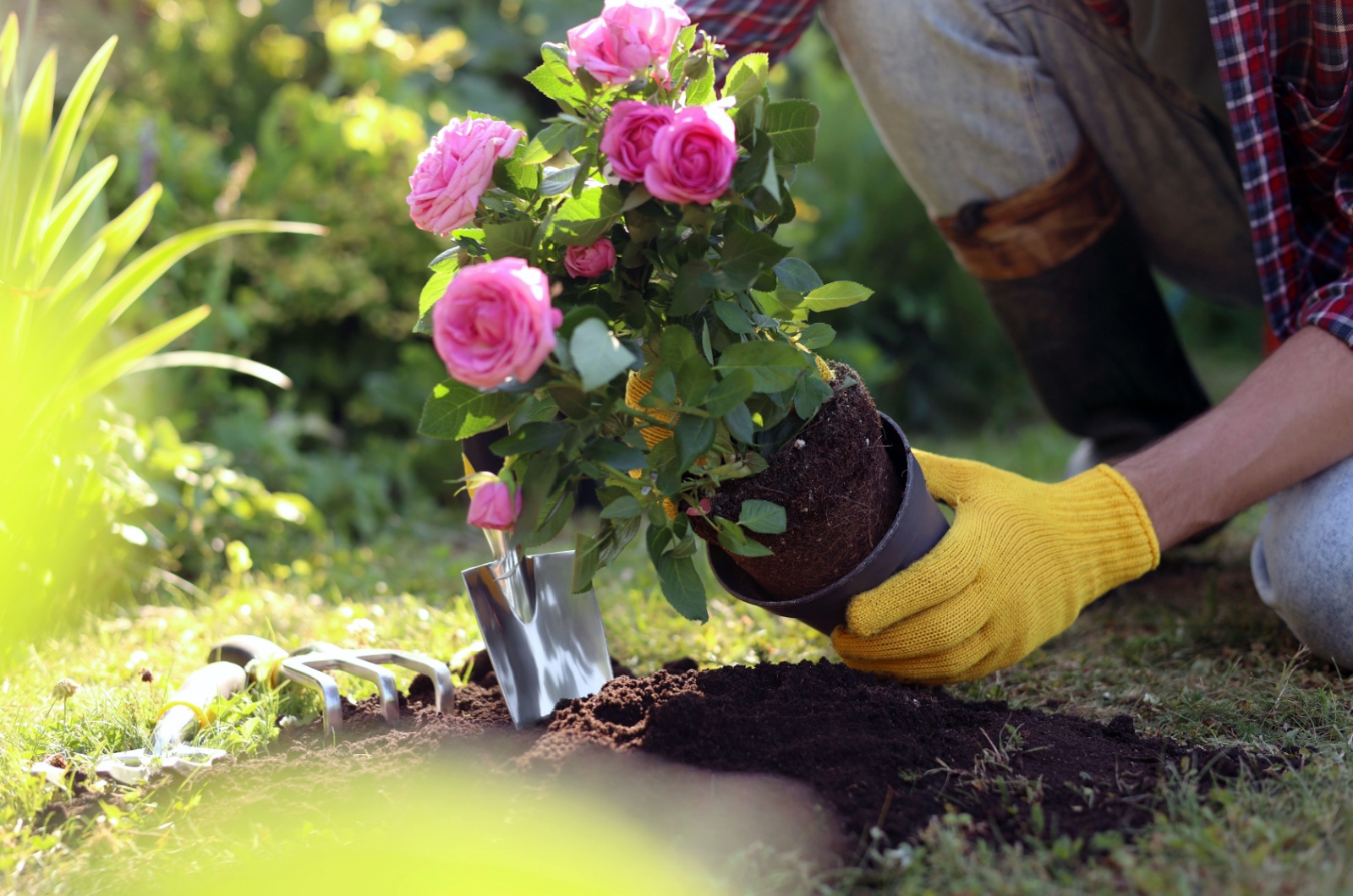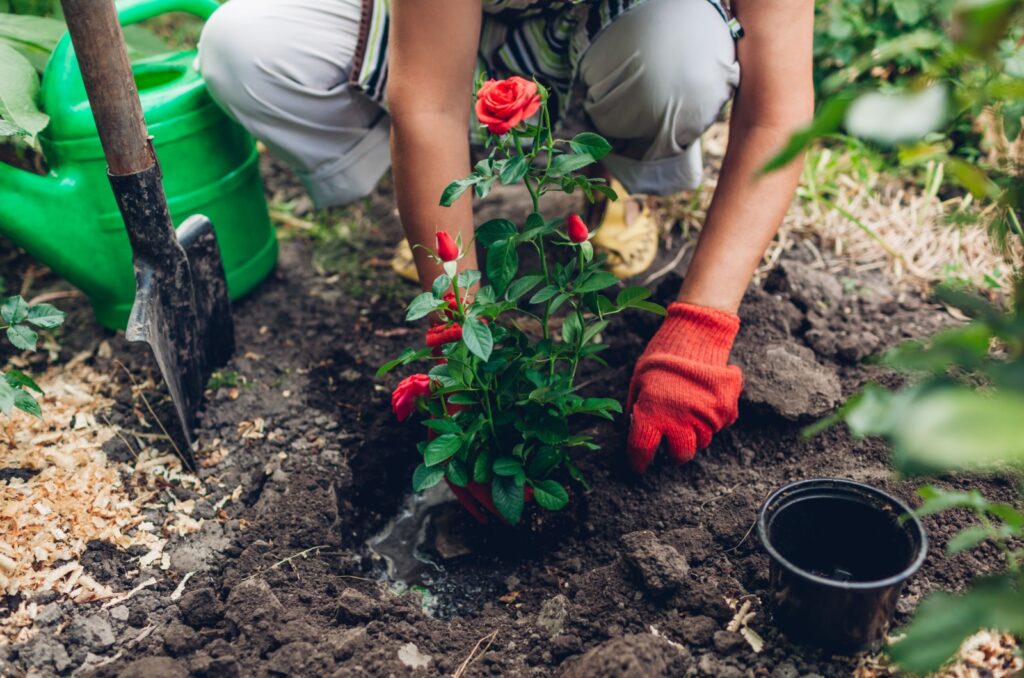If you’ve ever found yourself looking at your rose bush and thinking, “Hmm, maybe you’d look better over there“, you’re not alone. I recently decided to give my beloved roses a new spot in the garden, and to be honest, it was an adventure.
Moving a rose bush isn’t just about digging it up and plopping it down somewhere else – it’s a delicate operation that requires some skill and a whole lot of love!
The first time I tried to transplant my roses, I was nervous but excited. All I had was my trusty spade and hope (if you have nothing else, you always have hope!). Spoiler alert: my roses not only survived but thrived in their new location!
No worries, I’ll gladly share with you my tips and tricks so you can give your roses a fresh start. All you have to do is…
1. Wait Patiently Until The Time Is Right
The best time to transplant roses is in early spring or fall, so be patient!
You’ll want to move your rose bush when there’s no risk of frost (trust me, cold weather is not for roses). From my experience, early spring is perfect, right before your roses break dormancy.
What if you need to move your precious flowers during the summer? Don’t worry, it’s doable – just aim for early summer to minimize the stress on your plant.
While it may experience some transplant shock and appear a bit wilted or sad initially, this is normal. With proper care, it will bounce back once its roots are established in the new location.
One more tip: avoid moving roses in late fall or just before winter, otherwise they won’t have enough time to establish before the freezing temperatures kick in.
Related: Master The Art Of Cultivating Climbing Roses And Watch Your Outdoor Space Blossom Beyond Limits
2. Prepare Your Roses For The Move
When moving roses, it’s crucial to prune them properly before transplanting. Trust me, this step makes a world of difference.
Grab your sharp secateurs (I love using these Felco pruning shears from Walmart) and get ready to move your roses.
My go-to method is cutting the stems back to about 12 inches from the plant’s root ball. I know that it might seem a bit harsh, but it’s necessary. Pruning back old stems helps the rose bush focus on root growth and re-establishing itself in its new location.
I remember feeling a bit hesitant the first time I did this, but it really helps your roses thrive in the long run.
Once the main stems are pruned, it’s a good idea to remove any foliage from the remaining stems so that the plant can develop strong roots. It might look a bit bare at first, but your roses will thank you later.
Another tip from my own gardening adventures: water your rose bush the day before you plan to move it. This is especially important if you’re transplanting in spring, when temperatures can rise quickly.
A well-hydrated rose handles the move much better and settles into its new spot with less stress.
3. Handle The Transition Professionally
After preparing your rose by pruning it back and watering it the day before, it’s time to get your tools ready.
Dig up your roses on a mild and dry day (try to lift as much of the plant’s root ball as possible). You could do a circle around the rose, and then switch between a spade and a fork to tease the roots.
While it’s crucial to get as much of the root ball as possible, don’t stress if you have to cut a few roots that are too wide or deep. It’s all part of the process!
After you’ve lifted the rose bush, move it to its new location, ideally a spot where no roses have grown before.
Then you should dig a slightly larger hole and add to it some fertilizer and soil rich in essential nutrients.
I’ve found that bone meal, which you can get from Walmart, helps roses establish new roots easily.
After placing the rose bush in its new home, backfill the soil around it and water thoroughly. Avoid fertilization until some new foliage appears.
For the first year, using fish fertilizer (also available from Walmart) can really boost the plant’s health as it settles into its new spot.
Also read: 5 Tips To Make Your Roses Last Longer
4. Take Good Care Of Your Roses Afterwards
Now that you’ve successfully transplanted your roses, make sure to give them a deep soaking. Keep watering with 3 to 5 gallons of water once or twice a week (depending on the weather, of course).
If the weather is hotter, you might need to water more; if you’ve had rain, you can cut back a bit.
When I moved my roses last spring, consistent watering made all the difference. Once a month, give your roses a fish fertilizer when you are watering them.
Don’t use any granular fertilizer because it can be super harmful to new roots that the plant is sending out.
If you transplant in the spring, the plant should thrive in no time. This spring, I moved my ‘Cherry Parfait’ roses, and they’re doing fantastic!
But if you transplanted in the summer, give it a few weeks to recover and be careful with your watering.
I know that transplanting can be a bit tricky, but with the right care and attention, your roses will easily adjust to their new home. Remember, the key is to be patient and attentive to your roses’ needs as they are settling in.
Good luck with everything and send some pics of your roses!
Also read: Got Roses For Women’s Day? Use Them To Grow Completely New Plants!





